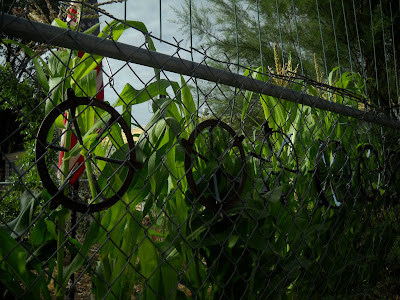The Gallup Farmers' Market really seemed to kick into gear this week. Several more vendors were set-up (7 booths in total) selling a variety of produce, home-made crafts and beautiful clothes, and sustainable living/recycling information. But, the biggest change was the lively groups of elderly people with their $4 WIC Farmers Market checks in hand, right when the market opened! The Gallup Independent also had their reporter and photographer preparing a story about the market. I was without a camera this week at the market.
The senior WIC program; NM is far more progressive than we're given credit for!
As with each week yet this season, I sold 80% of the produce I brought in the first 20 minutes. I love the fact that most of my crop goes to appreciative people who will surely let little go to waste, but discussions with other growers and feedback from customers will prompt me to raise my prices a little in the coming weeks. Though I've said it before, I'll reiterate I don't do this for the money (the therapeutic value of growing food is priceless), it's really nice to have such a fun time trading a dozen produce-filled baskets (a full Subaru wagon worth) for spending money the rest of the week ($72 this week:)
The candy-cane stripped Chioggia Beet- an italian heirloom- 1 of 4 beet varieties i've had for sale
The Saturday morning harvest began again this week at 7:30 and I made it to the market around 8:45 (the second to last grower to arrive, I was stuck with the less desirable sunny spot at the south end of the alley). I would've arrived significantly later, as the growing size of the harvest is taking longer and longer to bring in, if it weren't for the self-less volunteer help of my friend, Jessi- now an expert at rinsing onions, shallots, and beets. Not to mention an infinitely better retail sales manager than myself. Thank you!!!
So, in all I brought 16 different varieties of herbs and produce to the market, including pickling cucumbers and medium yellow dutch shallots for the first time this season. The former selling instantly in 6, $1 bunches of 7-8 small cucs. The latter in bunches of 5 for a dollar. Also for sale was a large head of cabbage ($3), white onions (10/$1), garlic ($1), rosemary, mint, sage ($1/bunch), collard greens, yellow beets, chioggia beets, cylindria beets (2-3/$1), bulls blood beets, cocozelle zucchini (striped italian heirloom), pepo zucs (round and great for stuffing), and male zucchini flowers (4/$1).
One of the best things about this week's market was hearing of how customers had prepared my produce from previous weeks. Here are some of the more memorable (i'll write them down in the future) recipes I heard:
Strawberry, watermelon salad topped with my mint
Zucchini flowers stuffed with braised mutton and rice
Zucchini flowers stuffed with crumbled goat cheese, battered, and fried like a chile relleno
Zucchini squash (large) stuffed with its chopped self, onions, cheese, and bread crumbs
Chioggia beet salad with goat cheese, walnuts, and balsamic vinegar
Mint leaves frozen individually in ice-cubes for a pretty aperitif garnish
The Gallup Farmers' Market runs each Saturday morning from 8:30-10:30 in the downtown walkway between Aztec and Coal street. The market manager is Carole Palmer and vendor booths are $5/day.


























































